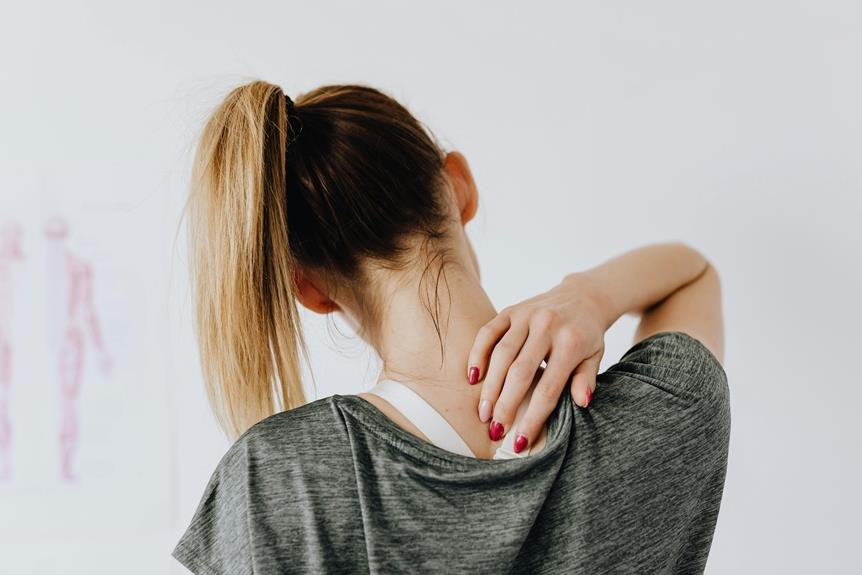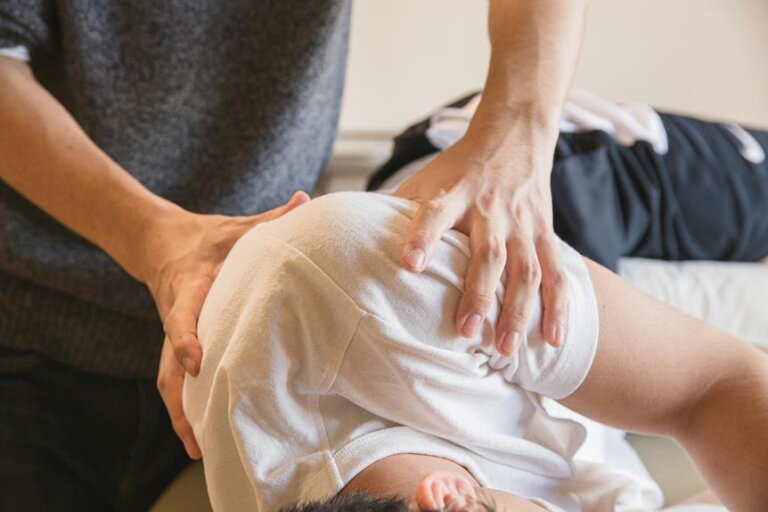Understanding the Causes of Back Pain in Those Over 50
As you navigate the winding path of aging, your back may start to whisper hints of discomfort, a subtle reminder of the miles you've traveled. But have you ever paused to ponder the intricate reasons behind this back pain that sneaks up on you?
Understanding the causes of back pain in individuals over 50 goes beyond just the passage of time; it delves deeper into the very core of your body's mechanics, shedding light on the intricate interplay of various factors that contribute to this common issue.
Degenerative Changes in the Spine
As you age past 50, degenerative changes in your spine can contribute to back pain. These changes may include the breakdown of spinal discs, which act as cushions between the vertebrae, leading to conditions like herniated discs or spinal stenosis. The wear and tear on your spine over the years can also result in the formation of bone spurs, causing pain and reducing flexibility.
Furthermore, as the discs between your vertebrae degenerate, they lose water content and become less effective at absorbing shock. This can lead to increased friction between the vertebrae during movement, causing pain and stiffness in the back. Additionally, the loss of disc height can result in changes to the alignment of the spine, potentially leading to conditions like osteoarthritis.
It is important to maintain a healthy lifestyle, including regular exercise and proper posture, to help slow down the degenerative process in your spine and reduce the likelihood of experiencing back pain as you age.
Muscle Weakness and Atrophy
Muscle weakness and atrophy can significantly contribute to back pain in individuals over the age of 50. As you grow older, there's a natural decline in muscle mass and strength, a condition known as sarcopenia. This weakening of the muscles can lead to instability in the spine and surrounding structures, putting excess strain on the back. When muscles are weak, they're less able to support the spine properly, leading to poor posture and abnormal spinal alignment. This can result in increased pressure on the vertebrae and discs, causing pain and discomfort.
To combat muscle weakness and atrophy, incorporating regular strength training exercises into your routine is crucial. Focus on exercises that target the back muscles, core muscles, and lower body to help support the spine and improve overall stability. Additionally, maintaining a healthy diet rich in protein and nutrients can aid in preserving muscle mass and strength as you age. By addressing muscle weakness and atrophy, you can reduce the risk of back pain and improve your overall quality of life.
Poor Posture and Alignment
When you slouch or sit for long periods, your spine can suffer from misalignment, leading to back pain.
Your sedentary habits can weaken core muscles crucial for supporting your back, exacerbating the issue.
Muscle imbalances caused by poor posture can strain your back muscles, contributing to discomfort and pain.
Sitting Position Impact
Improper sitting posture and alignment can significantly contribute to back pain in individuals over the age of 50. When you hunch over or slouch while sitting for extended periods, it puts excessive strain on your back muscles and ligaments. This strain can lead to discomfort and pain in the lower back region.
To prevent this, ensure your feet are flat on the floor, your back is well-supported by the chair, and your shoulders are relaxed. Make a conscious effort to sit up straight and avoid crossing your legs for prolonged periods.
Sedentary Lifestyle Effects
Maintaining a sedentary lifestyle can have detrimental effects on your posture and alignment, potentially contributing to back pain in individuals over the age of 50. Sitting for prolonged periods can lead to poor posture habits, such as slouching or hunching over, which can strain the muscles and ligaments in your back. Over time, this can cause imbalances in muscle strength and flexibility, further exacerbating issues with alignment.
Poor alignment puts unnecessary pressure on the spine and surrounding structures, leading to discomfort and pain. To combat these effects, it's essential to incorporate regular movement breaks, practice good posture while sitting, and engage in exercises that promote core strength and flexibility. By addressing these factors, you can help mitigate the risk of back pain associated with a sedentary lifestyle.
Muscle Imbalances Contribution
Sedentary habits can lead to muscle imbalances that contribute to poor posture and alignment, increasing the risk of back pain in individuals over the age of 50. When certain muscles are consistently underused due to inactivity, they can weaken, while others become tight and overactive. This imbalance can pull the spine out of its natural alignment, causing strain on the muscles and ligaments supporting the back. Over time, this strain can result in chronic discomfort and pain.
To combat this issue, incorporating regular exercise routines that focus on strengthening the core muscles and improving flexibility is crucial. Additionally, being mindful of your posture throughout the day and making adjustments to support proper alignment can help alleviate back pain caused by muscle imbalances.
Osteoporosis and Bone Health
As you age, maintaining strong bones becomes increasingly vital in preventing back pain, with osteoporosis being a common culprit in individuals over 50. Osteoporosis is a condition characterized by the weakening of bones, making them more prone to fractures. In the spine, this can lead to compression fractures, causing pain and impacting overall mobility.
To promote bone health and reduce the risk of osteoporosis-related back pain, it's essential to focus on a few key aspects. Adequate intake of calcium and vitamin D is crucial for bone strength. Engaging in weight-bearing exercises, such as walking or strength training, can help maintain bone density. Additionally, avoiding smoking and excessive alcohol consumption is beneficial for overall bone health.
Regular bone density screenings can help detect osteoporosis early, allowing for timely intervention and management. By taking proactive steps to preserve bone health, you can significantly reduce the likelihood of experiencing back pain associated with osteoporosis as you age.
Disc Degeneration and Herniation
Disc degeneration and herniation can contribute significantly to back pain in individuals over 50. As you age, the discs in your spine lose water content and elasticity, becoming less flexible and more prone to degeneration. This degeneration can lead to discs becoming thinner and less able to cushion the vertebrae, causing pain and discomfort.
Herniated discs, also known as slipped or ruptured discs, occur when the soft inner core of the disc pushes out through the tougher outer layer. This can irritate nearby nerves in the spine, resulting in pain, numbness, or weakness in the back or legs. The risk of disc herniation increases with age due to the wear and tear the spine experiences over time.
Factors such as poor posture, improper lifting techniques, and repetitive movements can accelerate disc degeneration and increase the likelihood of herniation. It's essential to maintain a healthy weight, practice good posture, and engage in regular exercise to help prevent and manage disc-related back pain as you age.
Arthritis and Joint Inflammation
Arthritis and joint inflammation can significantly contribute to back pain in individuals over 50, particularly as the wear and tear on your spine increases with age. Osteoarthritis, the most common type of arthritis, affects the spine by breaking down the protective cartilage between your vertebrae, leading to pain, stiffness, and decreased mobility. Additionally, conditions like rheumatoid arthritis can cause inflammation in the facet joints of the spine, further exacerbating discomfort.
When arthritis affects the facet joints, it can result in a condition known as facet joint syndrome, characterized by localized tenderness, stiffness, and difficulty bending or twisting. This inflammation not only causes pain directly in the affected joints but can also lead to muscle spasms and nerve irritation, radiating pain throughout your back.
To manage arthritis-related back pain, a combination of gentle exercise, physical therapy, anti-inflammatory medications, and in some cases, injections or surgical interventions may be recommended. It's crucial to work closely with healthcare professionals to develop a personalized treatment plan that addresses your specific needs and helps alleviate discomfort caused by arthritis and joint inflammation.
Frequently Asked Questions
How Does Emotional Stress and Mental Health Impact Back Pain in Individuals Over 50?
When you're over 50, emotional stress and mental health can impact your back pain. Stress can tighten muscles, leading to discomfort. Mental health issues like anxiety may increase pain sensitivity. Finding ways to manage stress can help alleviate back pain.
Can Certain Dietary Habits or Nutritional Deficiencies Contribute to Back Pain in This Age Group?
Imagine a garden that needs the right nutrients to flourish; your body craves the same. Poor dietary habits or nutritional deficiencies can weaken your back's support system, potentially leading to pain and discomfort.
Are There Specific Exercises or Physical Activities That Should Be Avoided to Prevent Exacerbating Back Pain in Those Over 50?
To prevent exacerbating back pain in those over 50, avoid high-impact activities like heavy lifting or intense aerobics. Opt for gentle exercises such as walking, swimming, or yoga. Listen to your body's signals and modify your routine accordingly to protect your back.
Is There a Link Between Chronic Illnesses Such as Diabetes or Heart Disease and Back Pain in Older Individuals?
So you're wondering if chronic illnesses like diabetes or heart disease are buddies with back pain in folks over 50? Yep, these conditions can be like unwanted house guests crashing your spine party.
What Role Does Genetics Play in Predisposing Individuals Over 50 to Developing Back Pain Conditions?
Genetics can play a significant role in predisposing you to back pain conditions as you age. Factors like family history and inherited traits may contribute to your susceptibility to developing back issues as you get older.
Conclusion
So, now you understand the common causes of back pain in those over 50. Remember, taking steps to improve muscle strength, maintain good posture, and prioritize bone health can help prevent and manage this issue.
For example, Mary, a 55-year-old woman, started doing daily back strengthening exercises and noticed a significant reduction in her back pain within a few weeks.
Don't let back pain hold you back from living your best life!






